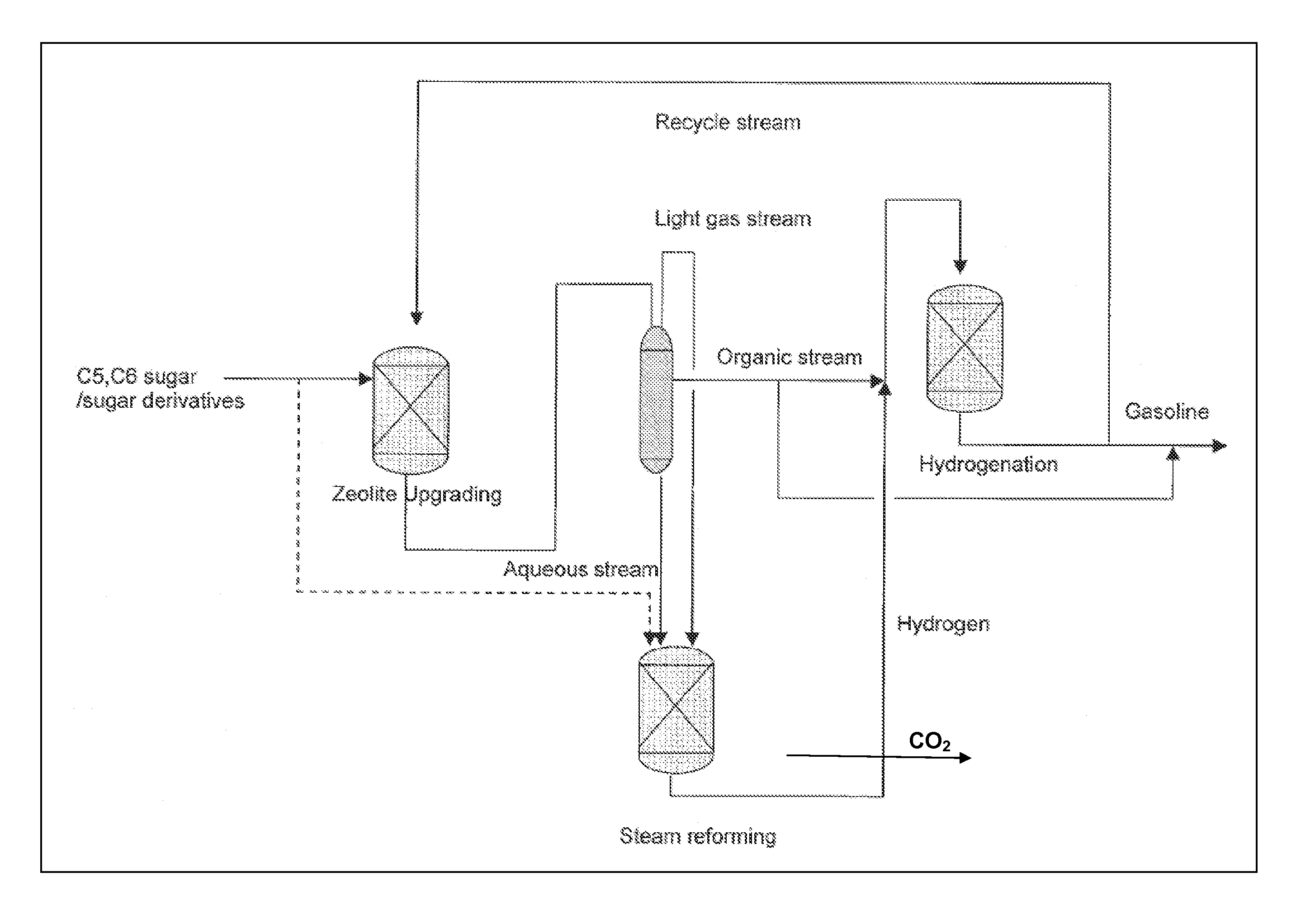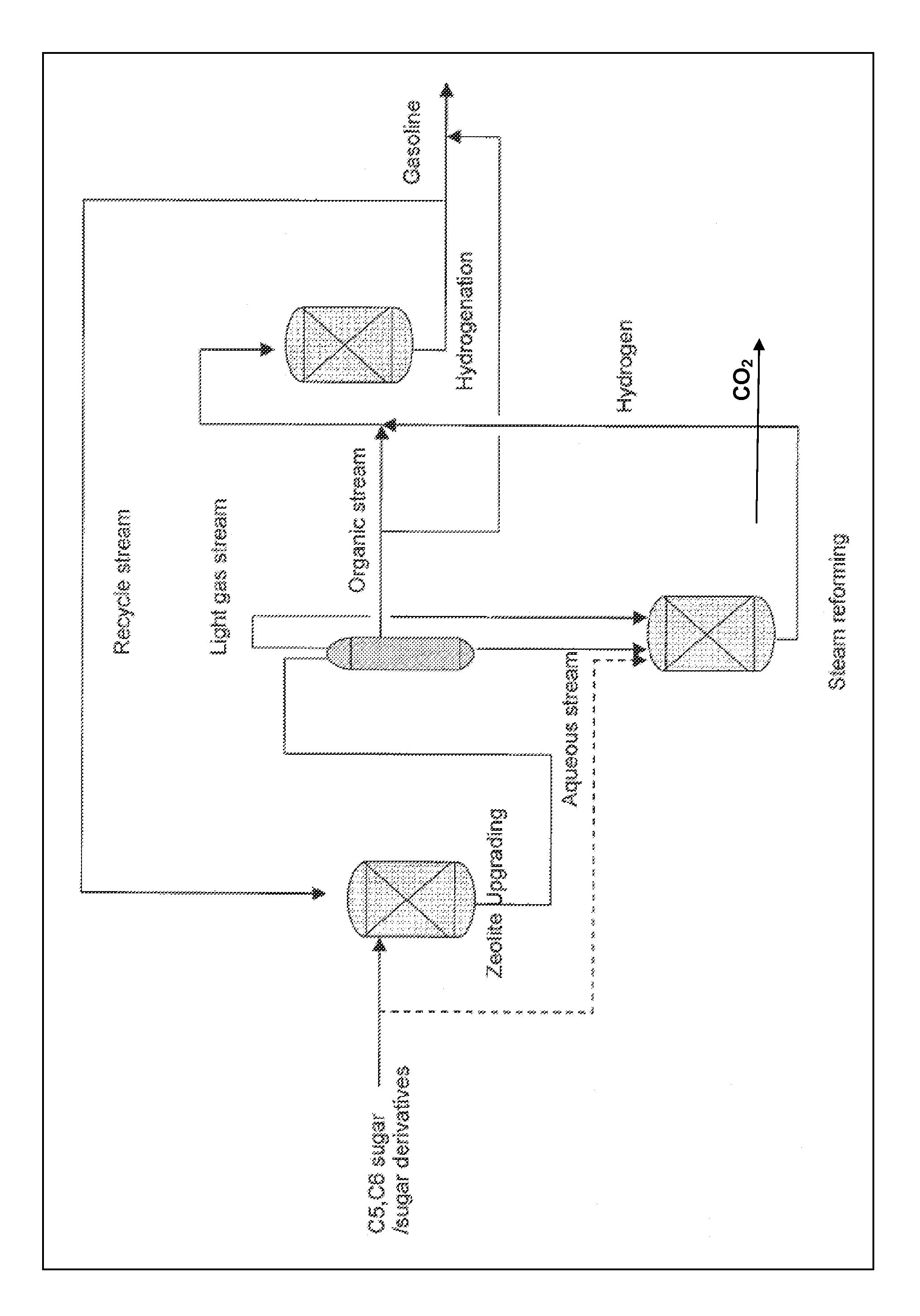Carbohydrates upgrading and hydrotreating to hydrocarbons
a technology of hydrocarbons and carbohydrate, which is applied in the direction of hydrocarbon oil treatment products, biofuels, fuels, etc., can solve the problems of low hydrogen to carbon ratio, easy conversion of sugar and sugar derivatives to coke, and low liquid yield, so as to reduce the rate of coke formation and the production of cox by-products during the conversion. , the effect of less effective hydrogen to carbon ratio
- Summary
- Abstract
- Description
- Claims
- Application Information
AI Technical Summary
Benefits of technology
Problems solved by technology
Method used
Image
Examples
example 1
[0047]In one example, as shown in Table I, toluene is a major product from zeolite reforming and methyl cyclohexane is a product after hydrogenation of toluene. Methyl cyclohexane was co-fed with sorbitol over a zeolite upgrading catalyst. The reaction was carried out at 450° C., 200 psig, with 8 g ZSM-5. The feed rates of sorbitol (70% sorbitol with 30% water) and methyl cyclohexane were 10 ml / hr and 12 ml / hr, respectively. The reaction products included greater than 50% C5+ hydrocarbons with a high percentage of those hydrocarbons being aromatic (58%). The high aromatic content and large number of C5+ hydrocarbons led to a gasoline product with an approximate octane rating of 99. This is an ideal octane rating for high performance gasoline fuels and exceeds the required octane rating for “premium” gasoline in the United States and “superplus” gasoline in Europe. This demonstrates that mixing a hydrogenated product from the product stream, methylcyclohexan...
example 2
[0049]The process in example 1 was repeated with xylitol (50 wt % aqueous solution) instead of sorbitol. The same process conditions were used, the reaction was carried out at 450° C., 200 psig, with 8 g ZSM-5. Xylitol (50% xylitol with 50% water) and methyl cyclohexane were fed at rates of 10 ml / hr and 12 ml / hr, respectively. Xylitol was converted into over 60% gasoline range hydrocarbons with and octane rating of 107.6. This high level of octane rating makes the fuel ideal for mixing to bring up the octane of fuels with lower octane ratings. Additionally, the high levels of conversion with sorbitol and xylitol indicate that polyols in general can be converted to gasoline quality fuels with high octane ratings of nearly 100 or greater than 100 from biological feedstocks comprising polyols and water.
[0050]
TABLE 2Xylitol processing to gasoline hydrocarbons.Run IDBOxygnate MoleculesXylitolHydrogen donorMethylcyclohexaneT(° C.)450Catalyst DescriptionZSM-5Produc...
example 3
1,5-Pentane Diol Zeolite Upgrading without Hydrogen Donor
[0052]An oxygenate mixture of 1,5-pentane diol (58 wt %), hydroxymethyl-tetrahydrofuran (THFA) (31 wt %) and methyl-tetrahydrofuran (11 wt %) was fed over a zeolite upgrading catalyst. The reaction was carried out at 450° C., 250 psig, using 12 g of zinc-modified ZSM-5 catalyst. The feed rate of the liquid oxygenate mixture was 9.94 ml / hr. Nitrogen gas at 200 sccm was co-fed to the reaction. The reaction products are shown in the Table 3 below.
[0053]
TABLE 31,5-Pentane Diol processing without hydrogen donor.Run IDCOxygenate Molecules1,5-pentane diol (58 wt %)THFA (31 wt %)methyl-tetrahydrofuran (11 wt %)Hydrogen donorNoneT(° C.)450Catalyst DescriptorZn-ZSM-5Oxygenate feed rate, g / hr9.94Production rate, g / hrC1-C4 Paraffins1.63C2-C4 Olefins0.056C5+4.14CO + CO20.68Coke0.25Oxygenate conversion, g / hr9.93Coke selectivity, wt %2.6Aromatics content in C5+ fraction (wt %)97%
PUM
| Property | Measurement | Unit |
|---|---|---|
| temperature | aaaaa | aaaaa |
| temperature | aaaaa | aaaaa |
| temperature | aaaaa | aaaaa |
Abstract
Description
Claims
Application Information
 Login to View More
Login to View More - R&D
- Intellectual Property
- Life Sciences
- Materials
- Tech Scout
- Unparalleled Data Quality
- Higher Quality Content
- 60% Fewer Hallucinations
Browse by: Latest US Patents, China's latest patents, Technical Efficacy Thesaurus, Application Domain, Technology Topic, Popular Technical Reports.
© 2025 PatSnap. All rights reserved.Legal|Privacy policy|Modern Slavery Act Transparency Statement|Sitemap|About US| Contact US: help@patsnap.com


